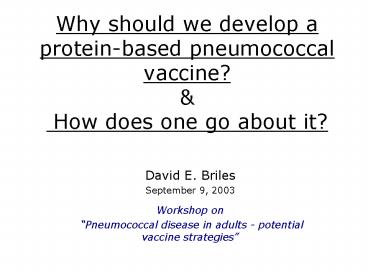Why should we develop a proteinbased pneumococcal vaccine PowerPoint PPT Presentation
1 / 26
Title: Why should we develop a proteinbased pneumococcal vaccine
1
Why should we develop a protein-based
pneumococcal vaccine? How does one go about it?
- David E. Briles
- September 9, 2003
- Workshop on
- Pneumococcal disease in adults - potential
vaccine strategies
2
(No Transcript)
3
Why look beyond carbohydrates?
- Present 23-valent vaccine is not effective enough
in the highest risk groups. - Conjugation of polysaccharides to a carrier has
not yet yielded an improved response in the
elderly. - 23-valent conjugate vaccine may be too complex
for present technology. - A high valence conjugate could be too expensive
for wide-spread use.
4
What are our choices?
- More and better viral vaccines.
- Adjuvants for 23-valent and conjugate vaccines.
- Control of carriage and transmission through
prophylactic anti-microbials. - Vaccines based on protein virulence factors to
control colonization and invasive disease.
5
The goals for a protein vaccine
- Prevention of
- Acquisition
- Colonization
- Transmission
- Invasion of tissues
- Evasion of phagocytosis
Herd Immunity
6
Uses of protein vaccine antigens
- In a stand-alone protein vaccine.
- To broaden conjugate vaccine protection.
- To provide a protection-eliciting carrier for
- protein-polysaccharide vaccines.
7
Strategy for protein vaccines
Identification of cross-reactive non-capsular
virulence factors critical for
- Colonization,
- Invasion of tissues,
- Evasion of phagocytosis.
8
Antibodies to proteins will probably not protect
by directly depositing C of the bacterial
surface.Surrogate assays designed for this
mechanism will probably not be appropriate for
proteins
9
(No Transcript)
10
(No Transcript)
11
(No Transcript)
12
(No Transcript)
13
(No Transcript)
14
(No Transcript)
15
(No Transcript)
16
Anti-PspA Enhanced Complement Deposition on
Pneumococci
Figure 9
Post-immune FB-/- sera
Pre-immune FB -/- sera
700
Anti-PspA
Post-immune NMS
600
Pre-immune NMS
500
400
Complement deposition
Mean fluorescence intensity
300
200
Normal Mouse Serum
100
0
0
10
20
30
40
50
pre- or post-immune (anti-PspA) serum
17
(No Transcript)
18
What we need
- Identification of optimal antigens
- Safe approved mucosal adjuvants
- Surrogates of protection
- Mechanism for approval and licensing
- Support from multiple sources to make protein
vaccines a reality.
19
2A Normal lung
2B Infected lung
20
Log10 CFU in lungs
Subcutaneous immunogens
21
(No Transcript)
22
Considerations for choosing new proteins for
pneumococcal vaccines
- Protection-eliciting
- Cross-reactive
- Expressed on a significant proportion of virulent
pneumococci. - Immunity protective against a diversity of
clinical isolates in animal models. - Immunity protects against (or contributes to
protection against) all virulent pneumococci.
23
Considerations for choosing new proteins for
pneumococcal vaccines
- Expressed in vivo
- Required for full virulence
- Knowledge of their role in virulence and disease.
- Knowledge of mechanism of antibody-mediated
protection.
24
Considerations for choosing new proteins for
pneumococcal vaccines
- Immunogenic in animals and man (adjuvants).
- Not toxic in animals and man
- Not immuno-dominant or non-immunogenic in
combinations - In vitro surrogate assay for protective responses
- Inexpensive production process
- Stable on storage
- Should be compared to proteins already studied
25
How can new vaccines be tested in man now that a
licensed vaccines exist?
- Test in countries or populations that can not
afford existing vaccines. -- This could apply
especially to childhood pneumonia vaccines. - Test for added protection. -- Since the
23-valent vaccine is not very effective in some
at-risk groups. - Use protein as a carrier and look for improved
protection. - Conduct placebo-controlled trials in groups
clearly not protected by existing vaccines.
26
Thank you
UAB lab Bing Ren Shaper Mirza Janice King Jason
Johnston Anders Hakansson James Watt Jie Li Mamie
Coats Yvette Hale
Susan Hollingshead UAB Moon Nahm
UAB Alex Szali UAB James Paton
Australia Eddie Ades
CDC Amanda Miller Aventis

